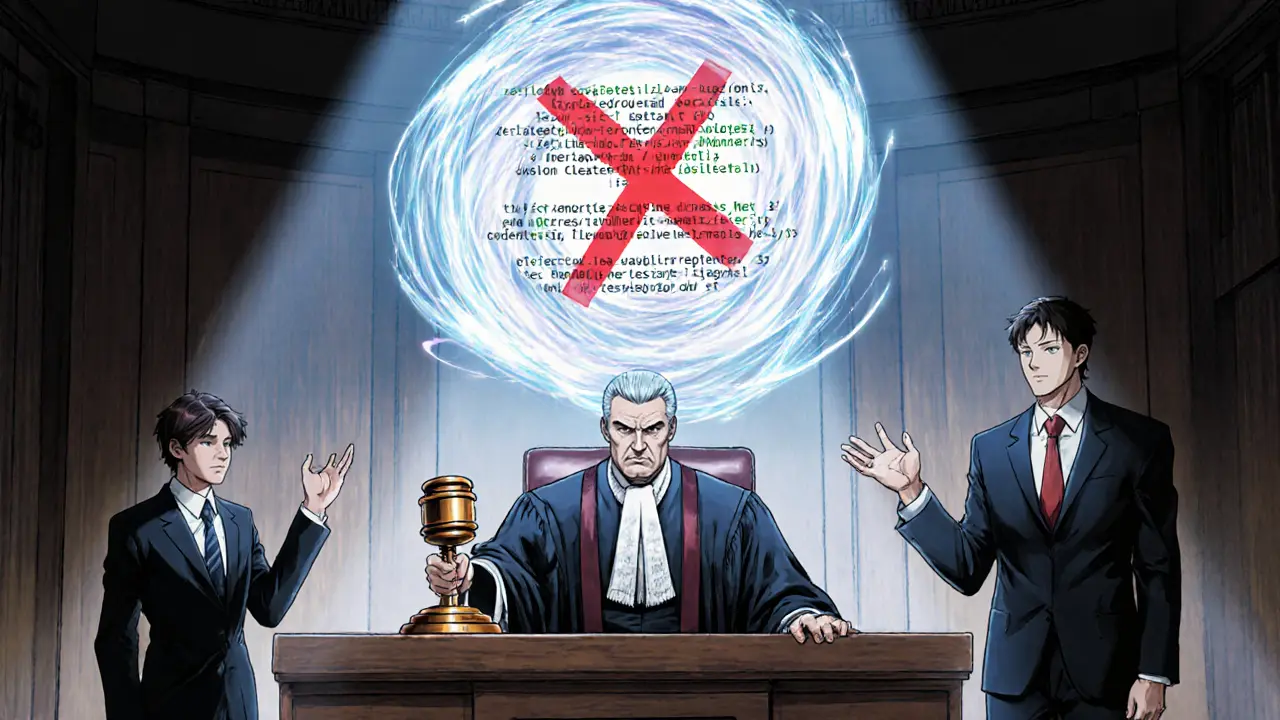Crypto Mixers & Tornado Cash Sanctions: What You Need to Know

Crypto Mixer Transaction Simulator
How Tornado Cash Works
This simulation demonstrates the core function of Tornado Cash: breaking the on-chain transaction link between sender and receiver.
Transaction Simulation Results
Original Transaction
Sender sends ETH to Tornado Cash contract
Pool & Obfuscation
Funds are pooled with other users' ETH in the contract
Funds are mixed with other deposits
Withdrawal to New Address
Withdrawal to a completely new address
When it comes to privacy‑focused tools, Tornado Cash is a non‑custodial Ethereum‑based crypto mixer that lets users break the link between sender and receiver on the blockchain. The platform quickly became a lightning rod for regulators because it can be used to hide illicit proceeds. If you’ve heard the term crypto mixers and wondered why governments keep shouting about them, this guide walks you through how TornadoCash works, why the U.S. Treasury slapped sanctions on it, what the courts decided, and what the whole saga means for the future of decentralized finance.
How Tornado Cash Obscures Transactions
At its core, a mixer (or tumbler) takes two basic steps:
- Users deposit Ether into a smart contract that holds the funds in a pooled address.
- Later they request a withdrawal to a completely new address they control. The contract randomly matches deposits to withdrawals, breaking the on‑chain trace.
The code is open‑source, runs on Ethereum, and does not require a middleman. Because the logic lives on an immutable blockchain, anyone can interact with the contract even if the original website disappears. In practice this means a user can send $10,000 in Ether, wait a few minutes, and pull out the same amount from a fresh address that has no visible link to the original sender.
Why the U.S. Treasury Targeted Tornado Cash
On August8,2022 the Office of Foreign Assets Control (OFAC) added TornadoCash to its Specially Designated Nationals (SDN) list under Executive Order13694, which targets “malicious cyber‑enabled activities.” The Treasury’s press release cited more than $7billion of Ether processed since launch, with a sizeable share tied to hacks and ransomware payouts, including:
- $455million stolen in the AxieInfinity hack allegedly linked to North Korea’s Lazarus Group.
- $96million from the Harmony Bridge breach (June2022).
- $7.8million from the Nomad bridge exploit (August2022).
OFAC’s order prohibited any U.S. person from interacting with the mixer’s contract addresses, creating immediate compliance headaches for exchanges, custodians, and even ordinary users who might have inadvertently used the service.
The Legal Push‑Back: VanLoon v. Department of Treasury
Developers and privacy advocates argued that sanctioning immutable code overstepped the Treasury’s authority under the International Emergency Economic Powers Act (IEEPA). In November2024 the FifthCircuit Court of Appeals ruled in VanLoon v. Dept. of Treasury that OFAC cannot treat a smart contract as “property” or an “interest in property” because the code is not a tangible asset that can be owned or transferred.
The court sent the case back to the District Court, ordering a partial summary judgment for the plaintiff. The ruling signaled that regulators might need a different legal tool to target decentralized protocols.

Sanctions Lifted-But Not Completely
On March21,2025 the Treasury announced it was removing the SDN designation from the TornadoCash smart contracts, allowing U.S. persons to interact with the code again. However, the agency kept sanctions on the two founders, RomanSemenov and RomanStorm, and retained a broader prohibition on anyone helping them evade the law.
In practice this means a U.S.‑based exchange can list the contract address again, but it must still screen for transactions that could be linked to the developers or to known illicit activity. The Department of Justice also filed criminal charges against RomanStorm for money‑laundering conspiracy, unlicensed money‑transmitting, and IEEPA violations.
What the TornadoCash Saga Means for Crypto Mixers
Privacy‑preserving tools are unlikely to disappear, but regulators now have a clearer blueprint for how to address them:
- Target the people, not the code. Future sanctions are expected to focus on developers, operators, or service providers that facilitate illicit use.
- Use existing AML/CTF frameworks. Exchanges must implement robust transaction monitoring that can flag mixer‑related patterns, even when the underlying protocol is technically legal.
- Watch for new legislative proposals. Lawmakers in the U.S. and EU are drafting bills that would give agencies explicit authority over “decentralized privacy tools.”
For users, the key takeaway is to stay aware of jurisdictional risk. Using a mixer in a country where it’s outright banned can expose you to civil penalties, while in the U.S. the current stance places the legal burden on developers rather than on casual users.
Quick Comparison: Pre‑Sanction vs Post‑Delisting
| Aspect | Before March2025 | After March2025 |
|---|---|---|
| Legal standing (U.S.) | SDN‑listed; all U.S. persons prohibited | Smart contracts removed from SDN; developers still sanctioned |
| Transaction volume | ~$200M/month (peak $3B) | ~$100M/month (rebound after delisting) |
| Exchange listings | Removed from most U.S. platforms | Allowed again, but with enhanced AML checks |
| Developer risk | None (before charges) | Criminal case against RomanStorm ongoing |

Compliance Checklist for Crypto Firms
If you run an exchange, wallet provider, or compliance service, use this short list to stay on the right side of the law when dealing with mixers like TornadoCash:
- Maintain an up‑to‑date SDN watchlist (including smart‑contract addresses).
- Implement pattern‑recognition rules for large, rapid deposits followed by withdrawals to fresh addresses.
- Screen counterparties for connections to known sanctioned developers (e.g., RomanSemenov, RomanStorm).
- Document any decisions to permit or block mixer interactions for audit purposes.
- Stay informed of upcoming legislative proposals in your jurisdiction.
Looking Ahead: The Future of Decentralized Privacy
Legal scholars say the TornadoCash case will be cited for years as the first successful challenge to a sanctions regime targeting code. Expect three trends to emerge:
- Regulatory sandboxes. Some jurisdictions may create controlled environments where developers can test privacy features without immediate bans.
- Hybrid mixers. New services are blending on‑chain mixing with off‑chain obfuscation, complicating the enforcement picture.
- International coordination. The U.S., EU, and Asian regulators are sharing intelligence on mixer usage tied to ransomware, making cross‑border compliance more critical than ever.
For everyday users, the lesson is simple: privacy tools exist, but they sit in a shifting legal landscape. Stay informed, understand the risks, and remember that the line between legitimate privacy and illicit laundering is drawn by regulators, not by the technology itself.
Frequently Asked Questions
What exactly does a crypto mixer do?
A crypto mixer receives cryptocurrency from a sender, pools it with other users’ funds, and then sends out the same amount to a new address chosen by the original user, effectively breaking the on‑chain link between the two.
Why did the U.S. Treasury sanction TornadoCash?
OFAC argued that TornadoCash was repeatedly used to launder proceeds from major hacks and ransomware attacks, violating Executive Order13694 that targets malicious cyber‑enabled activities.
Can I legally use TornadoCash in the United States after March2025?
Yes, the Treasury removed the SDN designation from the smart contracts, so U.S. persons may interact with the code again. However, any activity that aids the sanctioned developers remains prohibited.
What was the significance of the FifthCircuit ruling?
The court held that OFAC overreached by treating immutable smart‑contract code as “property” that can be sanctioned, setting a precedent that future sanctions must target people or services, not the code itself.
How should crypto exchanges handle mixer transactions?
They should flag large, rapid deposits followed by withdrawals to fresh addresses, screen for links to sanctioned developers, keep detailed logs for audit, and stay updated on SDN watchlists.
Pierce O'Donnell
September 15, 2025 AT 13:11Another day, another regulator trying to police code that anyone can read. It's absurd that they think sanctioning a smart contract will stop money laundering.
Vinoth Raja
September 22, 2025 AT 18:44When you peel back the layers of decentralized obfuscation, you realize we're essentially dealing with a probabilistic anonymity set built on deterministic ledgers. The mixer leverages zero‑knowledge-esque principles, albeit without any formal zk‑SNARKs, to scramble address linkages. From a game‑theory perspective, the equilibrium shifts once a sovereign entity tags the protocol as hostile. OFAC's move injects externalities that ripple through the incentive structure, pushing developers toward hybrid solutions. Ultimately, the cryptoeconomic landscape adapts, not freezes.
Kaitlyn Zimmerman
September 30, 2025 AT 00:16For anyone just getting started the key is to keep an eye on the SDN list and make sure your compliance software updates daily it’s a simple step that saves a lot of headaches down the line
DeAnna Brown
October 7, 2025 AT 05:48Wow, you’re really missing the bigger picture here – this isn’t just about one tool it’s about preserving financial sovereignty in the face of overreaching power plays and we can’t let regulators dictate how we protect our privacy
Chris Morano
October 14, 2025 AT 11:20Keeping a balanced view helps us all navigate these changes responsibly.
Ikenna Okonkwo
October 21, 2025 AT 16:53While the legal tug‑of‑war continues, it’s encouraging to see the community rally around robust compliance frameworks that respect both innovation and regulatory mandates.
Bobby Lind
October 28, 2025 AT 22:25Interesting read!!! The mix of legal nuance and tech detail really paints a clear picture of where we’re headed!!!
Sara Stewart
November 5, 2025 AT 03:57Let's sync up our AML monitoring modules with the latest TornadoCash address clusters so we can flag suspicious patterns without throttling legitimate user flows.
Hailey M.
November 12, 2025 AT 09:30Oh great, another regulator trying to “solve” privacy – because that always works 🙄😂
Schuyler Whetstone
November 19, 2025 AT 15:02People keep actin like this is some big deal but it’s just code they can fork any time y’all need to stop actin like it’s the end of the world.
David Moss
November 26, 2025 AT 20:34What they don’t tell you is that behind every sanction there’s a hidden agenda-engineered to funnel crypto profits back into shadowy state projects!!!
Cecilia Cecilia
December 4, 2025 AT 02:07The prudent approach is to monitor ongoing legislative developments and adjust compliance protocols accordingly.